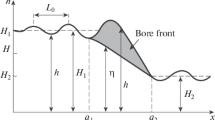Abstract
The basic conservation laws of the shallow water theory are deduced from the multidimensional integral conservation laws of mass and total impulse describing the flow of ideal incompressible fluid over the horizontal bottom. This derivation is based on the concept of the local hydrostatic approximation which generalizes the long wave approximation and is used to justify the application of the shallow water theory to modeling wave flows of fluid with hydraulic bores.
Similar content being viewed by others
References
Friedrichs, K.O., On the derivation of shallow water theory, Commun. Pure Appl. Math., 1948, vol. 1, pp. 109–134.
Stocker, J.J., Water Waves: The Mathematical Theory with Applications, New York: Wiley, 1957.
Chow, T., Open-Channel Hydraulics, New York: McGraw-Hill, 1959.
Henderson, F.M., Open Channel Flow, New York: MacMillan, 1966.
Ovsyannikov, L.V., To the grounding of shallow water theory, Din. Sploshnoi Sredy, 1973, no. 2, pp. 104–125.
Whitham, J., Linear and Nonlinear Waves, New York: Wiley, 1974.
Hibberd, S. and Peregrine, D.H., Surf and runup on a beach: a uniform bore, J. Fluid Mech., 1979, vol. 95, pp. 323–345.
Ovsyannikov, L.V., Makarenko, N.I., Nalimov, V.I., et al., Nelinenye problemmy teorii poverkhnostnykh i vnutrennikh voln (Nonlinear Problems of Surface and Internal Waves Theory), Novosibirsk: Nauka, 1985.
Shokin, Yu.I., Chubarov, L.B., Marchuk, A.G., and Simonov, K.V., Vychislitel’nyi eksperiment v probleme tsunami (Calculation Experiment in a Problem on Seismic Sea Wave), Novosibirsk: Nauka, 1989.
Yeh, H., Liu, P., and Synolakis, C.E., Long-Wave Runup Models, Singapore: World Sci., 1996.
Lyapidevskii, V.Yu. and Teshukov, V.M., Matematicheskie modeli rasprostraneniya dlinnykh voln v neodnorodnoi zhidkosti (Mathematical Models of Long Waves Propagation in Inhomogeneous Liquid), Novosibirsk: Sib. Otd. RAN, 2000.
Kulikovskii, A.G., Pogorelov, N.V., and Semenov, A.Yu., Matematicheskie voprosy chislennogo resheniya giperbolicheskikh sistem uravnenii (Mathematical Problems on Solving Numerically a Set of Hyperbolic Equations), Moscow: Fizmatlit, 2001.
Friedrichs, K.O. and Lax, P.D., Systems of conservation equation with convex extension, Proc. Nat. Acad. Sci: USA, 1971, vol. 68, pp. 1686–1688.
Lax, P.D., Hyperbolic Systems of Conservation Laws and the Mathematical Theory of Shock Waves, Philadelphia, PA: Soc. Industr. Appl. Math., 1972.
Ostapenko, V.V., The way to modify equations of shallow water theory which suppose discontinuous waves propagation along a wadi, Prikl. Mekh. Tekh. Fiz., 2007, vol. 48, no. 6, pp. 22–43.
Bukreev, V.I., Gusev, A.V., and Ostapenko, V.V., Destruction of liquid free surface discontinuity above the ledge of channel bottom, Izv. Akad. Nauk, Ser. Mekh. Zhidk. Gaza, 2003, no. 6, pp. 72–83.
Bukreev, V.I., Gusev, A.V., and Ostapenko, V.V., Waves in an open channel formed under shield remove in front of uneven bottom of shelf-type, Vodn. Resur., 2004, vol. 31, no. 5, pp. 540–545.
Gusev, A.V., Ostapenko, V.V., Malysheva, A.A., and Malysheva, I.A., Waves in an open channel formed by discontinuous wave flow above the bottom step, Prikl. Mekh. Tekh. Fiz., 2008, vol. 49, no. 1, pp. 31–44.
Richard, G.L. and Gavrilyuk, S.L., A new model of roll waves: comparison with Brock’s experiments, J. Fluid Mech., 2012, vol. 698, pp. 374–405.
Richard, G.L. and Gavrilyuk, S.L., The classical hydraulic jump in a model of shear shallow water flow, J. Fluid Mech., 2013, vol. 725, pp. 492–521.
Richard, G.L. and Gavrilyuk, S.L., Modelling turbulence generation in solitary waves on shear shallow water flows, J. Fluid Mech., 2015, vol. 773, pp. 49–74.
Atavin, A.A. and Shugrin, S.M., Differential equations in shallow water theory, Din. Sploshnoi Sredy, 1985, no. 70, pp. 25–53.
Ostapenko, V.V., O zakonakh sokhraneniya teorii melkoi vody, Dokl. Akad. Nauk, 2015, vol. 464, no. 5, pp. 558–561.
Ostapenko, V.V., K obosnovaniyu teorii melkoi vody, Dokl. Akad. Nauk, 2018, vol. 478, no. 2, pp. 158–163.
Freeman, N.C., Simple waves on shear flow: similarity solutions, J. Fluid Mech., 1972, vol. 56, pp. 257–263.
Green, A.E. and Naghdi, P.M., A derivation of equations for wave propagation in water of variable depth, J. Fluid Mech., 1976, vol. 78, pp. 237–246.
Author information
Authors and Affiliations
Corresponding author
Additional information
Original Russian Text © V.V. Ostapenko, 2018, published in Prikladnaya Matematika i Mekhanika, 2018, Vol. 82, No. 4, pp. 441–458.
Rights and permissions
About this article
Cite this article
Ostapenko, V.V. On the Application of Shallow Water Theory to Modeling Wave Flows with Hydraulic Bores. Fluid Dyn 53 (Suppl 2), 19–33 (2018). https://doi.org/10.1134/S0015462818060071
Received:
Published:
Issue Date:
DOI: https://doi.org/10.1134/S0015462818060071



